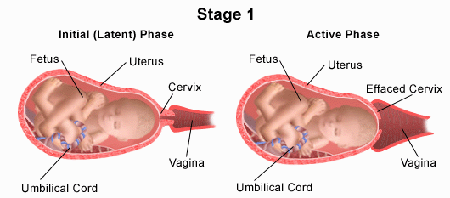Best Way to Understand and Prepare for Your First Stage of Labor
The longest stage of labor is the first. This is when you work the hardest. All of your childbirth preparation is used during this first stage. In early labor your body slowly gets ready for birth. Your contractions become regular and increase in frequency and length. You may see bloody mucus on your underwear or feel a trickle or strong gush of clear fluid from your vagina. Most of your early labor will be in your home. Generally, early labor is the longest phase of the first stage of labor, and the easiest. Early labor gently makes changes in your cervix and other parts of your body to prepare for birth.
Your goal in early labor is to try to remain as relaxed as possible. Engage in some mild activity that requires you to be upright and standing, such as walking. Ask your doctor or midwife if you can have a light snack with plenty of fluids. You should spend as much time as you can in the comfort of home before going to the hospital or birthing center, but follow your doctor’s instructions on when to come to the hospital or birthing center.
Active labor is defined by stronger and more rhythmic contractions. The contractions seem to build and subside like waves, and in most cases are felt over the entire abdomen, not just the lower part. Your uterus is getting down to business and your whole body will feel involved. The goal of active labor is to get your cervix almost completely open, to move the baby into position down in the pelvis, and to stimulate the baby for birth. Your water may break during active labor, or the doctor or midwife may break it with a small hook if she or he feels it might improve labor. Active labor is usually shorter than early labor and is often much more intense.
Your goal during active labor is to allow your body to do its job and to try to relax and conserve energy.
Transition labor is the shortest and most intense part of labor. If you were to liken it to a rafting trip, this would be the roughest “white water.” This is when your childbirth preparation—visualization, relaxation, and breathing—is critical. Contractions continue to get stronger last 60 to 90 seconds, and have almost no pause between them. When the cervix has dilated and effaced to 10 centimeters and the baby’s head enters the birth canal, you may feel an increase in pressure on your rectum and lower back. This pressure, along with the very strong contractions, is what makes transition labor uncomfortable. This is called the transition phase because your body transitions from the first, labor stage to the second, delivery stage. This is the shortest phase of labor but also the most challenging because you feel no ability to control your body.
Your goal during transition labor is to keep your focus, conserve energy, and let your body have control and do its job.
Categories
Advertisements
Recent Articles
 How to Understand Bed Sizes – A Small Guide
How to Understand Bed Sizes – A Small Guide How to Select Some Must Have Kitchen Accessories
How to Select Some Must Have Kitchen Accessories Best Way to Change a Car Tire
Best Way to Change a Car Tire Best Way to Write an Affirmation
Best Way to Write an Affirmation Best Way to Take Charge of Your Financial Life
Best Way to Take Charge of Your Financial Life Best Way to Survive a Party When You Don’t Know Anyone
Best Way to Survive a Party When You Don’t Know Anyone Best Way to Stop Self Sabotaging Yourself
Best Way to Stop Self Sabotaging Yourself Best Way to Start Journal Writing
Best Way to Start Journal Writing Best Way to Speak with a Powerful Voice
Best Way to Speak with a Powerful Voice Best Way to Simplify Your Life
Best Way to Simplify Your Life Best Way to Respond to a Put-Down
Best Way to Respond to a Put-Down Best Way to Reduce Acne Breakouts
Best Way to Reduce Acne Breakouts Best Way to Recover from Dining Disasters
Best Way to Recover from Dining Disasters Best Way to Quit Your Job Gracefully
Best Way to Quit Your Job Gracefully Best Way to Make Your Own Website
Best Way to Make Your Own Website


Leave a Reply